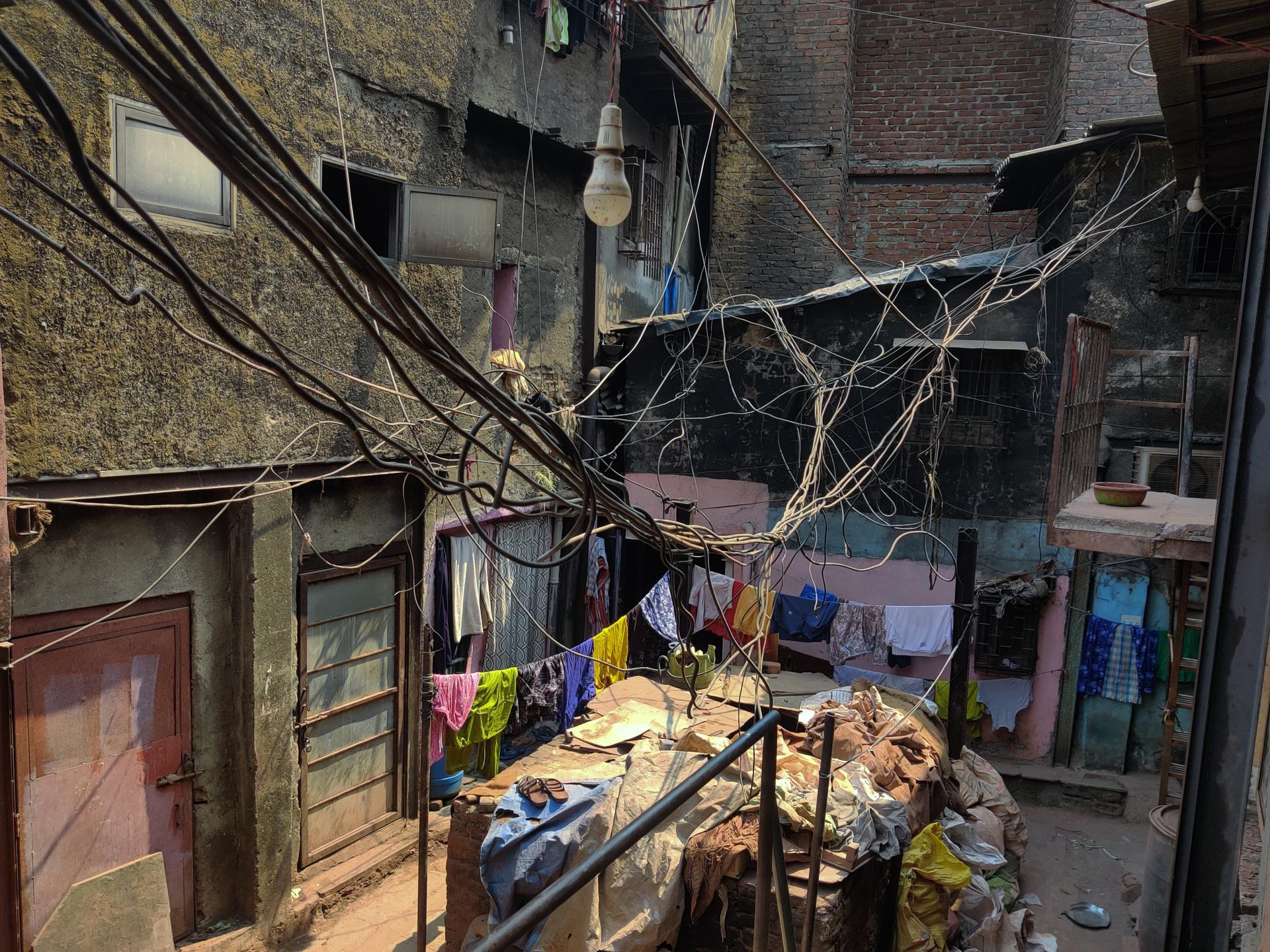Dharavi is known as the largest informal settlement in Asia, where 1 million people live in 1 square mile of Mumbai. For decades, it’s been slated for redevelopment. Plans are finally taking shape, but debates remain over where people will live and work.

At Abbas Zakaria Galwani’s clay-pot-making factory, a handful of men pack pots in boxes.
“We sell in cities across the country and even export to other countries,” Galwani said.
His factory in Dharavi, Asia’s largest informal settlement, in the middle of Mumbai, India’s financial capital, employs 22 people. It’s one of thousands of small industries in the settlement, where more than 1 million people live and work in 1 square mile on land that is mostly government owned.

One of India’s large conglomerates, the Adani Group, won an auction in January to work with the government to redevelop Dharavi. Photo Credit: Raksha Kumar for The World.
Dharavi’s open drains, naked electricity wires and narrow pathways packed with hordes of people have been featured in films like “Slumdog Millionaire.”
For 20 years, authorities have said they want to turn Dharavi into a modern township, complete with roads, schools, parks, hospitals and housing enclaves. Redevelopment plans continue to take shape, but many local residents like Galwani have resisted the proposals, fearing the impact of gentrification.
“We have no problems if you develop our land as long as the development benefits us as well,” he said, adding, “We fear they would displace us and redevelop the land to suit their needs.”
Galwani said that his family moved into Dharavi when it was nothing more than a swamp a hundred years ago.
“We feel a symbiotic relationship with this place. We gave it a shape, it gave us an identity,” he said.

Dharavi, in Mumbai, India, is home to a lot of potters. Photo Credit: Raksha Kumar for The World.
Families like his cleared out the marsh, built their homes and started small businesses that now contribute to over $1 billion in revenue every year.
Informal markets pack every street of Dharavi.
‘The largest con in history’
For real estate companies, Dharavi is a strategic location. The city’s two main train lines pass through Dharavi, and swanky neighborhoods surround it.

For real estate companies, Dharavi, in Mumbai, India, is a strategic location. The city’s two main train lines passing through it and swanky neighborhoods surround it. Photo Credit: Raksha Kumar for The World.
A huge government hospital that caters to millions of the city’s poor and middle-class populations sits in the middle of Dharavi.
One of India’s large conglomerates, the Adani Group, won an auction in January to work with the government to redevelop Dharavi. The $2.4-billion proposed plan to redevelop 260 hectares of the settlement would accommodate some people and businesses, but displace thousands — and the details are scarce, a CBC report says.
In January, Hindenburg Research, an investment firm, accused the Adani Group of pulling off “the largest con in corporate history.”

Dharavi, in the middle of Mumbai, India’s financial capital, is Asia’s largest informal settlement. Photo Credit: Raksha Kumar for The World.
Hindenburg published a document that said that the Adani Group was engaged in “brazen stock manipulation,” “accounting fraud” and money laundering,” which the group denied.
Since then, Dharavi residents have protested against the Adani Group. Also, the group’s market value has lost more than $110 billion as investors have pulled out.
The Adani Group has not made any statements on the redevelopment project yet.
Complicated factors
By some estimates, Dharavi has about 20,000 mini factories contained inside it. But it is precisely these industries that the government says need relocating.
CEO of the Dharavi Redevelopment Board SCR Srinivas told local media in January that Dharavi needs to develop so it doesn’t continue to add to Mumbai’s pollution.

A wall in Dharavi, in Mumbai, India, marked by graffiti. Photo Credit: Raksha Kumar for The World.
“Entire sewage [from Dharavi] is untreated [and] it is going into the Mithi river,” he said. “There are leather industries and textile industries there that are highly polluting.”
There is no drinking water and no sanitation. At the same time, Dharavi is bearing the burden of the city’s waste, not just its own.
According to Krishna Pujari, an entrepreneur who runs a travel company in Dharavi, 80% of the city’s waste is recycled in Dharavi.
“We are the reason waste has not piled up on the streets of Mumbai,” said Mohammad Irfan, who owns a recycling plant in Dharavi.
Smaller industries contribute to the pollution, too.
In the potters colony in Dharavi, kilns burn most of the time, adding smoke to narrow haphazardly built homes around it.
‘Do not put us out of work’
Still, people depend on their businesses for their livelihoods.
Many residents wonder whether the redevelopment plans would interfere with their ability to continue running their businesses.
Architect Sandhya Naidu said the biggest challenge in redeveloping Dharavi is ensuring that its people get to live and work there. So, any redevelopment plan “will have to be heavily influenced by people who have the lived experience of having been in Dharavi in all their lives.”
Back in his factory, Galwani was practicing a speech to give at the prestigious Indian Institute of Technology Bombay on pot making. He said that Dharavi gave him his identity.
“With time, there is bound to be change,” he said. “By all means, redevelop our informal settlement but do not put us out of work.”
Published in The World
Published on March 23, 2023
Link: Redevelopment proposal for Mumbai’s largest informal settlement stirs controversy | The World from PRX


